Performance cruiser part 2: The interior fittings are so different
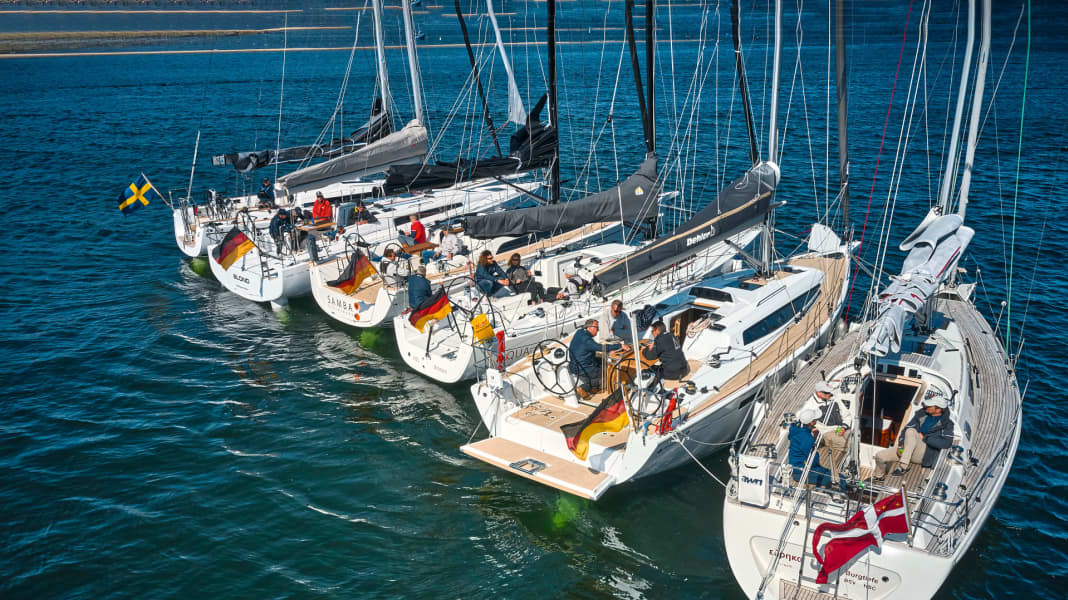
In the test:
- Arcona 385
- Dehler 38 SQ
- Faurby 370
- First 36
- J 112 E
- X 4.0
All parts of the performance cruiser comparison
In the first part of the large group test of performance cruisers around eleven metres in hull length, the YACHT test editors examined the performance and sailing characteristics of the six competitor yachts on the Flensburg Fjord in a direct comparison. We weighed up the designs against each other and explained which boats were easier and more efficient to trim and why. We also looked at handling and ergonomics for active sailing.
The conclusion after part 1: In terms of performance under sail, the six test yachts are almost on a par with each other. However, the Arcona 385 from Sweden has a small lead as the most powerful boat upwind. The First 36 from Beneteau, on the other hand, with its modern design, has the edge in a room wind under gennaker. Taking all the test criteria into account, the result after the first round is still fairly even.
The focus is now changed for the second part of this group test. Now the test boats have to literally show what they are made of. This issue is less about sport and more about comfort on board, living space, functionality and storage space. And, of course, we also take a look at the quality of the interior fittings. After all, this is exactly what should characterise a performance cruiser: high living comfort and excellent sailing performance.
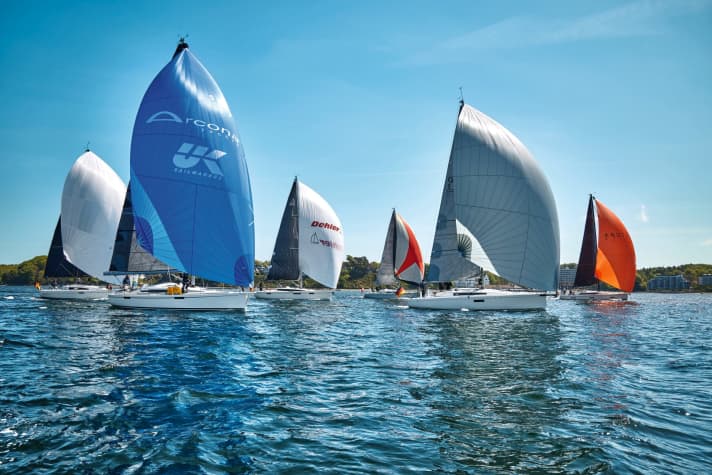
Hull moulds and layouts
A comparative look at hull shapes and layouts (see diagrams) makes it clear that the very different designs cannot offer the same volume below deck. The Faurby 370 from Denmark, for example, with a width of just 3.30 metres and a comparable hull length, is significantly slimmer than its competitors, especially aft. It therefore has only one cabin aft and one forward. The Faurby also occupies a special position because the shipyard works individually with the interior fittings and fulfils various special requests within the scope of what is possible. Faurby has already realised the 370 and the predecessor model 363 with two aft compartments on special request.
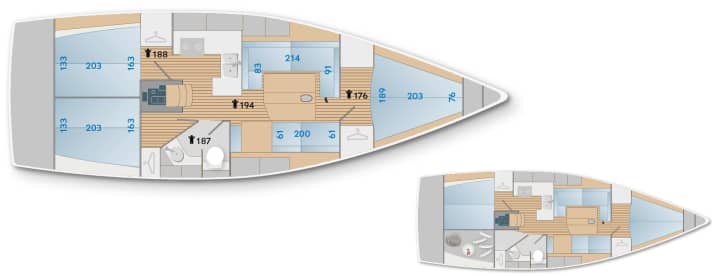
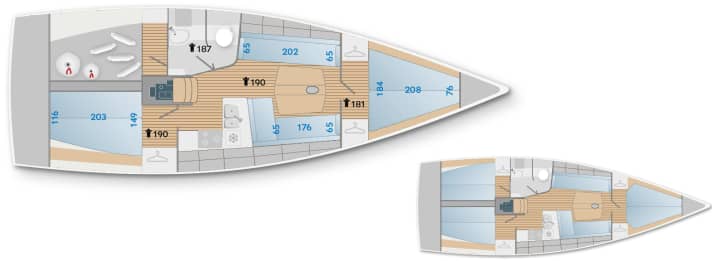



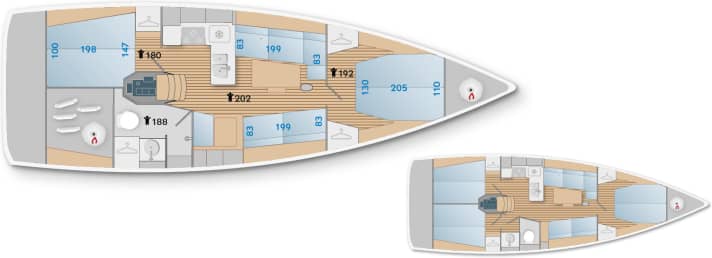
The hull lines of the J 112 E from France also converge slightly aft. The stern is narrow, so there is still a cabin aft and a compartment forward. Meanwhile, the hulls of the Arcona 385, the Dehler 38 SQ and the X 4.0 have comparably moderate hull shapes with similar dimensions, aspect ratios and volumes. Accordingly, all three boats offer a choice of two or three double cabins. The First 36 from Beneteau stands out in terms of design with its strikingly wide stern. In fact, its hull lines are almost wedge-shaped, with the widest point at the very stern. As a result, the Frenchwoman is built exclusively as a three-cabin boat without any expansion options, but offers more flexibility in terms of utilisation.
The interior fittings
The first impression below deck is important. The YACHT testers go from boat to boat in the Sonvik marina in Flensburg. Visually, there is a fairly clear demarcation. The Arcona 385 and the Faurby 370 represent the typical Scandinavian style with their classic, aisled and cosy interiors with lots of wood and an overall very homely feel. You immediately feel at home here and want to stay. The Danish interior appears more conservative, with light-coloured mahogany furniture, blue upholstery and curtains instead of blinds. At this point, however, it must be mentioned once again that Faurby can also cater to the owner's individual preferences when it comes to the interior style. In direct comparison, the interior of the Arcona is more modern and straightforward.
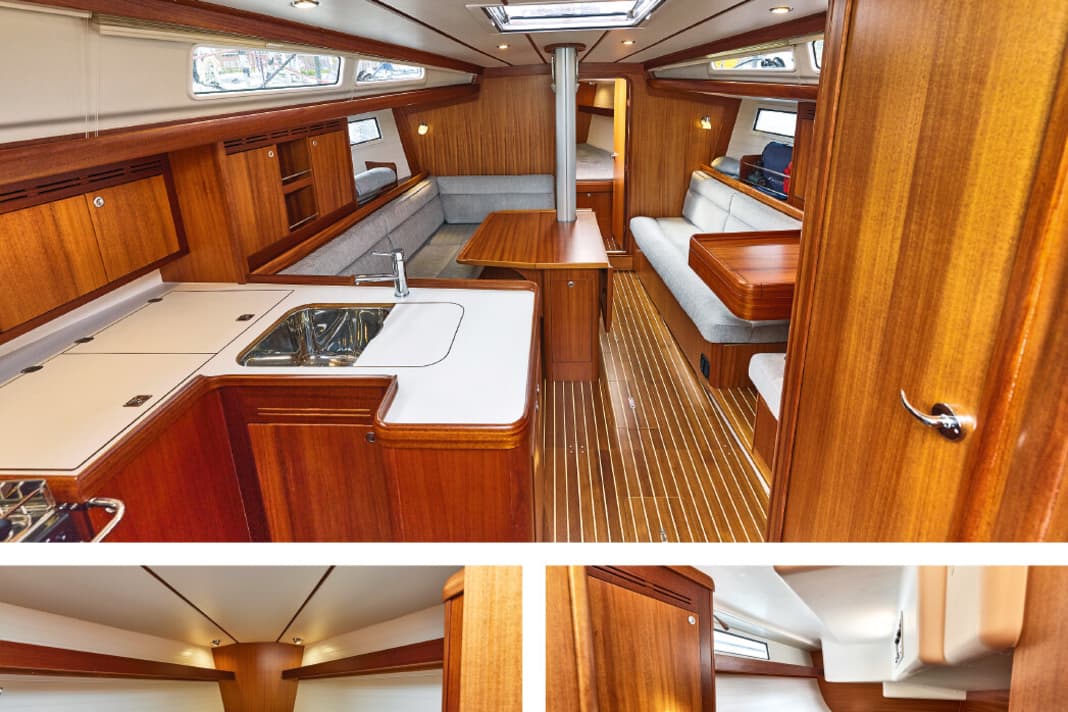





The counterparts to the traditional styles of the Nordic boats are the sportier class representatives from France, the J 112 E and the First 36 from Beneteau. The outfitting style of these two boats is relatively simple, sober and airy as well as light in terms of weight, especially in the First. The large, light-coloured and unobstructed plastic surfaces dominate, while the proportion of wood remains negligible. Classic cosiness is not the top priority here, but rather functionality and weight savings, even in the interior fittings. The sporty genes of the French-built American also come through in the standard of the interior fittings. Compared to the First, however, the J 112 E features more wood overall and the interior appears more cosy and inviting. In addition, the large double door to the foredeck opens up the interior visually, which further enhances the feeling of space.
The Dehler 38 SQ and the X 4.0 with their modern, light and unadorned interior styles are positioned between these two poles. In comparison, both boats score with a cosy ambience and a great sense of space. The full-length side storage compartments further emphasise the linear look. On the Dehler, the many surfaces covered with light-coloured fabric are also pleasing and provide even more cosiness below deck. Of course, the assessment of the impression of space here is also subject to personal preference.
On the other hand, the mere measurement data provides irrefutable findings. The Arcona 385 is the clear winner in terms of berth dimensions: the berth in the foredeck of the Swedish yacht is just under 1.90 metres wide at shoulder height. And the berths in the two aft cabins also offer the most comfortable dimensions with a width of 1.63 metres each. In the version with only one aft cabin, the berth is even significantly larger, because in this case the longitudinal bulkhead is installed aft, shifted to the side. The Dehler 38 SQ also scores highly in comparison with its very generously planned berths. The dimensions of the berths allow comfortable double occupancy in all three cabins.

Despite its slim hull shape, the Faurby 370 also offers sufficiently large berths forward (1.76 metres wide) and aft (1.55 metres). The aft berth is very long at 2.44 metres, but is bordered by the engine compartment in the head area. Because the Faurby's layout concept only provides for one cabin aft, the berth dimensions can benefit from a sideways-shifted longitudinal bulkhead.
This is also the case with the J 112 E, although the berth in the aft cabin is only 1.37 metres wide, making it less comfortable for two people. Due to its relatively low freeboard height, the berth in the J is installed relatively low in the rear of the boat to maintain a reasonable height between the berth and the cockpit floor. The sleeping area is therefore comparatively narrow. There is more space in the foredeck of the J with a berth width of 1.63 metres.
On the First 36, where, judging by the shape of the hull, the most volume should be available aft for fittings, the two double berths also remain relatively narrow, the berths are only 1.37 metres wide. The reason for this is the relatively wide technical channel, in which the diesel tank and the hot water boiler are installed, among other things. On the other hand, the Frenchwoman scores with the flexible use of the aft berths, which can be converted into single berths in no time at all. This means that the aft cabins can also be used in whole or in part as storage spaces - a good and clever solution with exemplary character. At 1.87 metres, the berth in the bow of the ridge is almost as wide as that of the Arcona 385.

The X 4.0 is the only boat in the test group to have an island bed in the foredeck, which offers a high level of comfort and is already a class standard for pure touring boats of the same size. The disadvantage of the largely free-standing berth, on which you sleep with your head forward, is the modest berth width of just 1.30 metres at the shoulders. On the other hand, the berth at the foot end is wider than with triangular berths, which can also be an argument in favour of the island bed. With a width of 1.47 metres, the aft berths on the Dane are also not really generously dimensioned in comparison.
Function versus comfort. Ideas differ when it comes to toilet facilities
On all six yachts in the group, the sofas in the saloon can also be used as additional berths with more or less comfort or restrictions. This is particularly well solved on the Faurby 370, where the backrest can simply be folded up as a whole to create a nice, comfortable single berth with a shoulder width of 88 centimetres. However, with a length of 1.91 metres, the berth is also short.
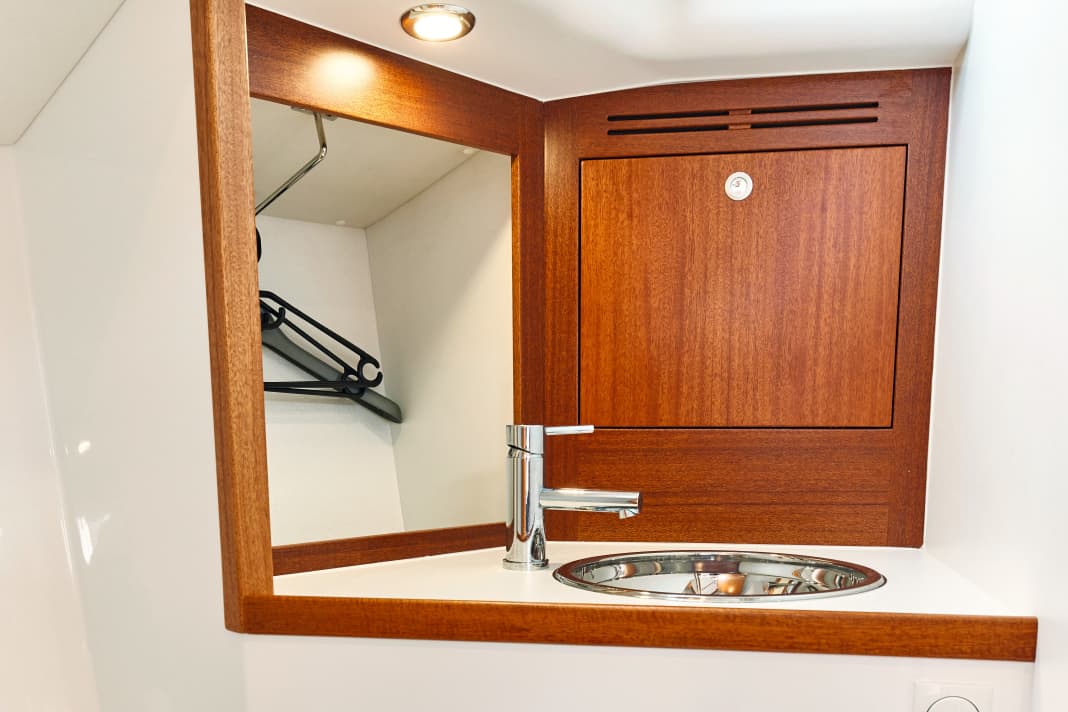





Fitted versions with one or two toilet rooms are the class standard on cruising yachts with a hull length of around eleven metres. On the sportier boats in this comparison, however, there is only one wet room. On the First 36, this is very small and simple. And as a special feature, the toilet room is installed in the bow and not further aft as on the competitor boats. To make better use of the modest space available, the washbasin can be folded up - another detail on the Frenchwoman that is familiar from earlier times. The wet room on the J 112 E is also relatively small and compact in comparison. However, the toilet and washbasin are quite usable.
On the Arcona 385 and the X 4.0, the size and functionality of the bathroom depend on whether the boats are fitted with one or two aft cabins. If there is still one aft cabin, the wet room is extended in both cases to include a shower area with a spatial partition. On the Arcona, the washbasin is relatively small, but the toilet room is extended to include an open cupboard for wet oilskins. The wet room on the slim Faurby remains relatively narrow and cramped, but also offers a separate area for showering, albeit without a partition.
The clear winner in the special wet room category is the Dehler. Her bathroom is very well thought out and the space is perfectly usable for all needs. The toilet room also serves as a shower cubicle. The innovative "Uni Door" concept from Dehler, in which the door to the saloon doubles as a shower wall, provides separation. If the Dehler 38 SQ is fitted with two aft cabins, the cabin on the port side is only accessible through the bathroom. This is the compromise in favour of this beautiful, large and functional toilet room, which also boasts plenty of usable storage space.
In the pantry, it's not just the size that counts, but also the working height and cupboard layout
In the galleys, the Arcona 385 and the X 4.0 are ahead in terms of the size of the usable work surfaces and the number and organisation of the storage compartments and drawers. On the Dehler and the Faurby, the available work surfaces are smaller in comparison. On the boat from Greifswald, however, it is noticeable that the kitchen cover is at a higher level, making it comfortable and easy to work standing up. This is quite different on the J 112 E, where the work surfaces are significantly lower (84 centimetres). Working at the hob or sink requires a stooped posture, which is tiring in the long run.
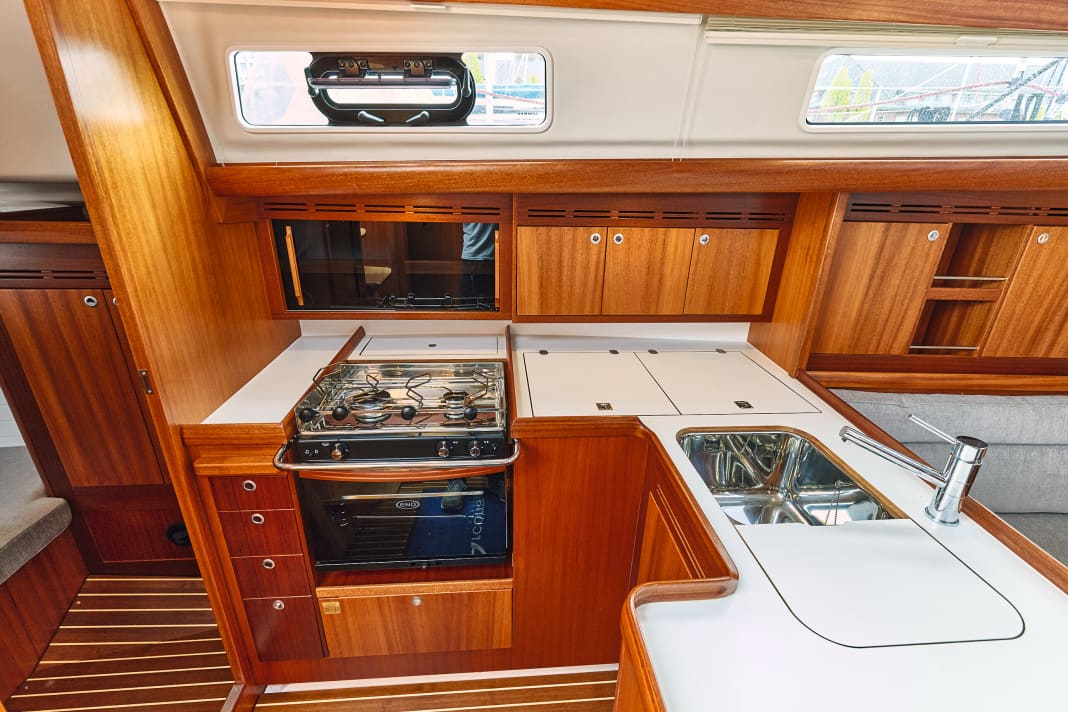





The First 36 is the smallest kitchen with the fewest storage spaces, but what is unusual and special about it is the central stand-alone pantry block with its large, deep refrigerator compartment. A shelf can be used to close the gap between the central box element and the actual kitchen module, which in turn considerably increases the work surface. This is another rather innovative and well-functioning detail on the new Beneteau boat.
The navigation station
The X 4.0 is perfect for those who like to work with a chart and compass when travelling. The chart table is large enough for this, the seating position in the direction of travel is perfect with good support even when the boat is moving and heeling. The workstation on the First 36 is also very seaworthy, although the work surface for charts is a little too small. J/Boats takes a very generous approach to the 112 E and gives the navigation corner plenty of space for a good and relaxed seating position. The chart table is also ideal as a fully-fledged workstation in the boat office.
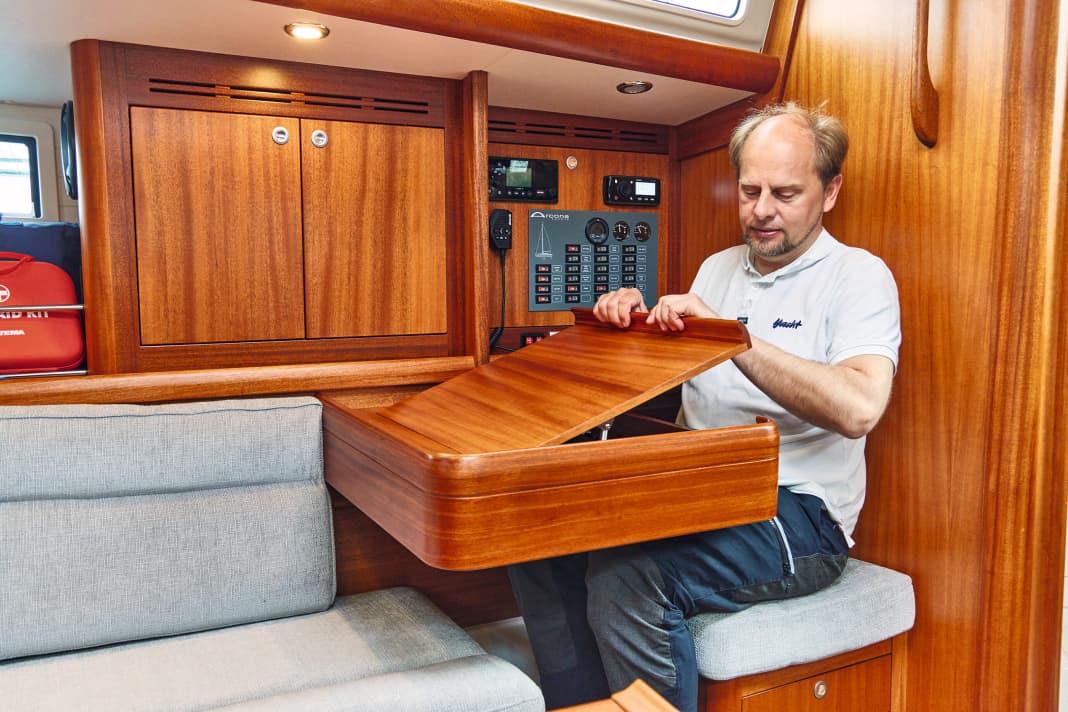





Navigation on the Faurby test boat is again a customised solution. Although the table is the largest in terms of surface area in comparison, the seating position on the sofa with the back facing the direction of travel is not ideal and provides little support in rough seas. The Arcona offers a flexible solution with a movable chart table. In principle, this is a good facility that can be used as required, but the desk area is too small to work well with the chart and the space for sitting is generally limited. The Dehler 38 SQ has by far the smallest navigation system in the comparison. The rear-facing table is too small in practice and is much more useful for storing small items. However, Dehler also offers the complete navigation module as an option in a sliding version, similar to the Arcona.
In terms of ventilation, the differences within the test group are striking. On the Dehler 38 SQ and also on the X 4.0, all the large superstructure windows can be opened. Together with the deck hatches, they allow perfect cross ventilation. On the Arcona, there are only two very small openings in the saloon, but the Swede is equipped with good dorade vents right from the shipyard, which allow permanent ventilation. And in the foredeck, the hatch on the Arcona is the largest (60 by 60 centimetres) in comparison. This not only provides plenty of light in the ship, but also additional fresh air in the forward area of the ship.
On the Faurby - how could it be otherwise - opening windows are of course available on request. However, the test boat is only equipped with one window that can be opened via the galley. Together with the deck hatch, this means that cross-ventilation is only possible to a limited extent. On the two French boats, the options for air exchange are rather modest. In addition to relatively small deck hatches, both the First 36 and the J 112 E have only very small openings. Effective ventilation is generally more difficult here.
On all six boats in the comparison, the bathrooms have at least one window on the side or a hatch in the cabin roof. The bathrooms on the X-Yachts, Dehler and J/Boats boats even have two openings each. Good ventilation with a draught is particularly important in the toilet and shower rooms.
The range of storage space differs greatly
The amount of stowage space available essentially depends on where and how much possible stowage volume is already built in through technical installations such as water and fuel tanks. Another decisive factor is whether the boats have been fitted with one or two aft cabins and whether or not a large aft locker is available. It is therefore very difficult to make a comparative assessment of the storage space available within the test group. On the Dehler 38 SQ and on the J 112 E, the water tanks are installed in the foredeck under the bunk. This means that there is only limited storage space available there, if any at all. Additional storage space is available under the sofa berths, which is easier, better and quicker to access.
The opposite is true for the other competitors. On the Arcona 385, Faurby 370, First 36 and X 4.0, the large fresh water tanks are installed laterally under the benches in the saloon. This means that there is plenty of storage space under the bunk in the foredeck, but this is sometimes difficult to reach because the cushions and bunk boards have to be completely removed. The perfect solution is offered by the X 4.0, where the entire bed base can be folded up with the help of gas pressure springs, making the storage spaces underneath very easily accessible. Arcona addresses this issue with large drawers built under the bed in the foredeck - also good.
All six boats in the competition have at least one large locker in the cabins aft and forward. The storage space is also extended with open shelves to the side. The exception is the J 112 E, on which there are no additional storage compartments in the living areas aft and forward, but only side-hinged stowage pockets, which are of limited use and offer little space. In contrast, the storage space in the foredeck of the X 4.0 is extended on both sides with hanging lockers. However, these are only offered as an option at the shipyard. This, together with the elegant island bed, gives the foredeck of the X 4.0 the general character of a designated owner's cabin, as on a pure cruising boat.
Scandinavian boats set high standards in terms of interior quality
Finally, looking at the quality of workmanship in the interior fittings, the Faurby 370 from Denmark can once again significantly improve its score in comparison. The excellent and loving craftsmanship in every detail is striking. The furniture is customised by the Danes for each individual boat. The grain and colour tones harmonise perfectly, transitions are barely visible, the gap dimensions are spot on, cut edges are sanded and sealed - it really doesn't get any better than this. The boats from Arcona and X-Yachts also shine with very good finishing quality. There are hardly any points of criticism for them either. The paintwork is impeccable, the veneers strong and solid, the sealing joints between the interior modules fine and narrow, the cushions thick and comfortable. And creaking floorboards are not an issue on any of the three boats of Scandinavian origin.
In comparison, on the Dehler, the J 112 E and the First 36, the traces of mass production are more clearly visible in parts. The gap dimensions are not equally accurate everywhere, and some of the built-in parts are only roughly cut and not painted over. In addition, the floorboards creak under load in many places. In addition, the upholstery on the sofas and berths of the J and the First is thin. On the Dehler, the upholstery is thicker and more comfortable.
Conclusion
The short conclusion after part 2 of the group tests: In terms of interior fittings, the six test boats are generally much more heterogeneous than in their sailing performance and characteristics. The advantages and disadvantages are more pronounced, the differences more striking. Nevertheless, a comparative look at all the test criteria ultimately produces a fairly balanced picture. The best boat does not yet exist.
Rating Arcona 385
Noble-looking interior with very good workmanship. The berths are the largest in comparison
- Living and finishing quality
- + Separate shower possible
- + High-quality interior fittings
- - Cross ventilation hardly possible
Rating Dehler 38 SQ
Cosy and inviting interior, plus plenty of storage space in the saloon. The berths are nice and large
- Living and finishing quality
- + Modern living ambience
- + Large, functional wet room
- - Very small navigation
Rating Faurby 370
The build quality is excellent. However, the slim hull shapes demand compromises in the comfort dimensions
- Living and finishing quality
- + Highly customisable
- + Beautiful, classic extension
- - Little space in the bathroom
Rating First 36
Simple and very sober interior design on the Beneteau. Cosiness is rather neglected
- Living and finishing quality
- + Functional interior fittings
- + Many innovative details
- - Little usable storage space
Rating J 112 E
The interior is quite simply designed, but impresses with its high level of functionality. The rear berth is narrow
- Living and finishing quality
- + Appealing sense of space
- + Good usable wet room
- - Pantry with low working height
Rating X 4.0
Beautifully built interior with a straightforward, unadorned appearance
- Living and finishing quality
- + Modern, bright style
- + Plenty of headroom throughout
- - Island bed narrow at the front
All parts of the performance cruiser comparison

